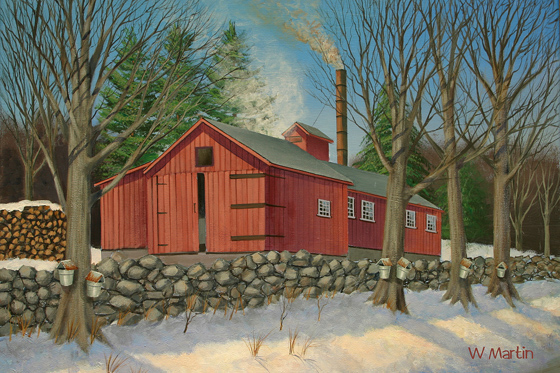The Maples by Corinne H. Smith
inspired by a painting by Walter L. Martin of Johnson's Sugar House in Orange, Mass.
|
Thousands of years ago, the last glacier slowly crept away And left in its wake a singular habitat, a cycle of seasons That tested the endurance of many a living thing in New England. Each one learned to adapt to the conditions it was faced with And to survive the wet springs, hot summers, brilliant falls, And intermittently lengthy winters, reminiscent of that old ice pack. But Spring came early to the Maples. While the rest of the landscape remained carpeted in snow, Those trees stood tall and skeletal and seemingly immobile. And deep inside each one of them, a river began to flow: One that transformed the earth’s energy into a secret saccharine elixir. And savvy squirrels nibbled at the tips of the branches, Filling their cheeks with pure clear sweetness That caused them to chase their siblings & rivals from trunk to trunk: A swirl of gleeful gray against a background of white; A whirl of bustle, in otherwise absolute silence. New beings eventually arrived on the scene: Ones that didn't migrate and didn't hibernate, But built sturdy homes & lived off the same piece of land year round; And, except for some routine warring against others of their kind, Made every effort to live in harmony with the other creatures & plants And hoped that their own supplies would last through the long winter. But Spring came early to the Maples. And after watching the squirrels, the Native Americans Cut gashes into the bark during The Sugar Moon And collected tree teardrops in woven birch baskets, And gave thanks to the forest that fed them when game became scarce.
They showed the colonists how a chance drip of the ladle to the pot |
To the settlers, the rushing river meant power; And a mile north of the booming town center, Solomon Johnson had bought the old Jones farm On the road to North Orange, in the lee of the Tully Mountains. Both he and Anna knew that it wasn't quite like their native Sweden. Income from dairy cows supported their growing family, But they also learned how to tap the trees on the property: Setting up an operation that made one luscious amber gallon From every 40 gallons of transparent nectar the children gathered. The community maple sugar suppers were not to be missed. Now as our slow cold winter days drag into infinity, Men in top hats rouse the dozing groundhog; Store clerks silently trade crimson hearts for emerald clovers; Motorists mutter while scraping ice from windshields -- again; Snowbirds mail us annoying beach postcards from Florida; Gardeners sigh as they turn the pages of colorful bulb catalogs. And Spring comes early to the Maples. And after a few cold nights and crisp blue-sky days, We spy whiffs of steam rising from the sugar house chimney As members of the fourth, fifth and sixth generations of Johnsons Hook up their pipes and empty the contents of 3,000 buckets. And like those old Russian canines, we get our mouths ready As we take our seats at the breakfast tables, Bumping into flannel shirts scented with wood, Ready to accept the gravy of the gods, that golden liquid joy And the knowledge that Life does indeed go on. |
May 2008
 Walter L. Martin's painting, Johnson's Farm, which depicts the actual sugar house in Orange, Massachusetts. Thanks, Wally!
Blogs |
Books |
Non-Fiction|
Stories |
Poetry |